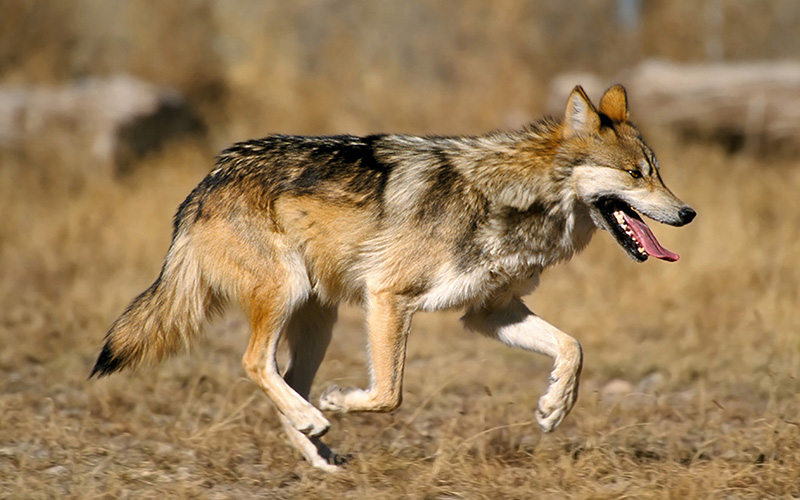
A Mexican gray wolf in a photo taken in 2006. There were 113 wolves recorded in Arizona and New Mexico last year, the most since reintroduction of the endangered species began in 1998. (Photo by Jim Clark/U.S. Fish and Wildlife Service)

A Mexican gray wolf at the Sevilleta National Wildlife Refuge in New Mexico in a photo from 2010. Growing numbers of the endangered wolves have ranchers concerned about depredation. (Photo by Jim Clark/U.S. Fish and Wildlife Service)
WASHINGTON – Populations of endangered Mexican gray wolves have reached their highest numbers since reintroduction efforts began nearly 20 years ago, but rather than cheer the success, environmentalists are worried it could backfire on the struggling animals.
With wolf numbers – and wolf predation – on the rise, state, local and cattle industry officials have renewed their push to have a greater say in controlling its population.
Sen. Jeff Flake, R-Arizona, reintroduced a bill last month to require that the U.S. Fish and Wildlife Service work with states, counties, and local stakeholders to sustain wolf populations without adversely impacting livestock, wild game or recreation.
Fish and Wildlife is required to finalize a recovery plan for the wolves by November. If the agency does not comply with Arizona and New Mexico in the design of the plan, the states would be able to dictate the terms of the recovery process under the bill, which was co-sponsored by Sen. John McCain, R-Arizona.
“This legislation doesn’t just let the fox guard the henhouse – it gives the fox title and deed,” said Michael J. Robinson with the Center for Biological Diversity. He said decisions on managing the animal need to be based on science and not politics.
But Flake said the current system isn’t working.
“The federal government’s outdated management of Mexican gray wolf populations is harming ranchers and our state’s rural communities,” he said in a statement released by his office. “This bill will ease the burdens on rural Arizonans by enhancing local stakeholder participation and state involvement in the recovery process.”
Mexican gray wolves are a subspecies of wolf in Arizona and New Mexico that was almost killed off in the 1970s because of the damage they did to cattle. The government began reintroducing the wolves into the Southwest in 1998 but conservationists say recovery has been slow due to inbreeding and poaching.
The Fish and Wildlife Service said last month that there were 113 Mexican gray wolves throughout Arizona and New Mexico in 2016, an increase from the 97 counted a year earlier. But Robinson said that although the species’ growth last year is encouraging, there need to be more in the wild to ensure genetic diversity and the animal’s survival.
“Scientists have been saying there is a real genetic problem here,” Robinson said. “They have pointed to studies that have shown there are fewer wolf pups being born and of the ones that are born, fewer of those are surviving to maturity as a result of genetic factors.”
But Patrick Bray, executive vice president of the Arizona Cattleman’s Association, said no recovery plan will be successful if the federal government leaves local authorities out of the loop.
“You need cattleman, sportsman and others at the table, because at the end of the day, the government still gets a paycheck and the rest of us on the other side of the table have to live and deal with their messes,” Bray said.
He said ranchers have first-hand experience with the messes caused by the wolves.
“Even though the area is a small geographical area when you look at the U.S., it is devastating when in one year alone there has been one individual who has lost 18 head of cattle” to wolves, Bray said. “You do that times $1,000 and that’s $18,000 the federal government has deliberately ripped out of your pocket.”
Cassie Lyman, a sixth-generation Gila County cattle rancher, supports the call for local input, saying wolves are being released without a plan or any government compensation for depredation.
“We have a lot of predators and we live in harmony with them, but we also have a plan,” Lyman said. “If numbers (of animals) are increasing and causing negative effects to the habitat, then we can increase tag numbers and hunt them.”
But that is not the case with endangered animals like the gray wolf, she said.
“If there are animals having negative effects on cattle we can remove them, but when we have an environmentally protected species, those things don’t apply,” Lyman said.
She said there should be a cap on the size of the population to establish when the wolves can be removed from the endangered species list, a provision in Flake’s bill.
But Robinson said the idea of putting a cap on the species runs counter to the concept of recovery. With Flake’s legislation, he said, the states would have control over when the wolf could be taken off the endangered species list, even if scientists determined the animal is still in trouble.
“This is really a wolf extinction bill that Senator Flake has introduced. It’s very worrisome and it’s exactly the kind of political interference that the endangered species act was supposed to counter,” Robinson said.
Flake’s bill, introduced on Feb. 14, has been referred to the Senate Committee on Environment and Public Works but has yet to get a hearing. A similar bill died in that committee in the last Congress.